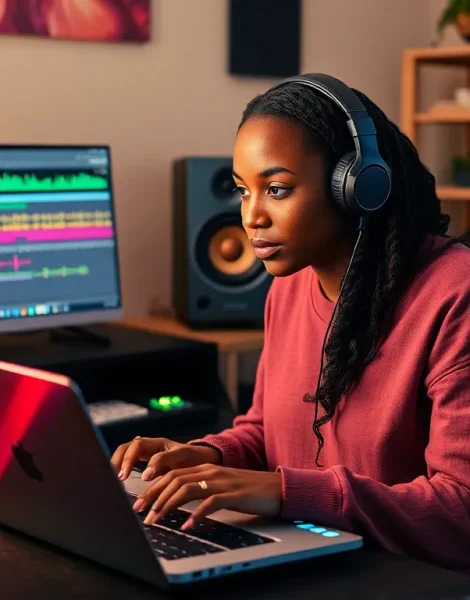In a world where anyone can be the next chart-topping sensation, music production software is the secret weapon every aspiring artist needs. Gone are the days of lugging around heavy equipment and spending hours in a studio. Now, all it takes is a laptop and a sprinkle of creativity to turn a catchy tune into a viral hit.
Table of Contents
ToggleOverview of Music Production Software
Music production software transforms how artists create music. These tools enable musicians to produce high-quality tracks without needing extensive equipment or studio space.
Definition and Purpose
Music production software refers to digital tools designed for creating, recording, editing, and mixing audio tracks. Its primary purpose is to simplify the music-making process, allowing users to harness technology for enhanced creativity. Beginners and professionals alike rely on these software options to manipulate sound and control every aspect of production. Streamlined workflows and user-friendly interfaces foster efficient music creation. Users can compose, mix, and polish their songs all in one place, eliminating the need for cumbersome setups.
Types of Music Production Software
Several types of music production software cater to diverse needs and preferences. Digital Audio Workstations (DAWs) serve as the backbone for most music production. Popular examples include Ableton Live, Logic Pro, and FL Studio. These programs facilitate recording, arranging, and mixing audio. Also, virtual instruments enhance creativity through synthesizers and samplers, emulating traditional sounds in a digital format. Audio editing software focuses on refining recordings, offering tools for optimizing sound quality. Lastly, plugins enrich music tracks, providing effects and additional sounds that expand sonic possibilities.
Key Features to Consider

Selecting the right music production software involves considering several key features that impact usability and creativity. He or she should evaluate each aspect carefully to ensure the chosen software meets their needs.
User Interface and Usability
A straightforward user interface enhances productivity. Beginners often benefit from software that prioritizes intuitive navigation. Complex features shouldn’t overwhelm users; instead, they should offer efficient workflows. Tutorials and community support available within the software can expedite the learning curve. Prioritize software that allows seamless integration of features, making it easier to focus on creativity rather than technical hurdles.
Built-in Instruments and Effects
Quality built-in instruments and effects expand creative possibilities. High-end software includes synthesizers, drum machines, and samplers ready for use. Effects like reverb, delay, and compression enhance sound shaping. Versatile sound libraries equipped with various genres support diverse music styles. Check for customizable instruments to cater to personal preferences and unique sound design.
Compatibility and System Requirements
Compatibility ensures the software operates smoothly on various systems. Users should check if the software supports their operating system, whether Windows or macOS. Minimum RAM and processor speed requirements impact performance, especially during heavy projects. Additionally, compatibility with external hardware, such as MIDI controllers and audio interfaces, often enhances the production experience. Regular updates indicate ongoing support and improvements, ensuring longevity in usability.
Popular Music Production Software Options
Music production software provides various solutions suited for different skill levels. Aspiring producers find numerous options that cater to their needs and preferences.
Software for Beginners
Beginners often benefit from user-friendly software that encourages exploration. GarageBand offers a simple interface and a robust set of tools, making it perfect for newcomers. Another entry-level option is Soundtrap, which operates in the cloud, facilitating collaboration. BandLab also caters to beginners with a straightforward setup and accessible features. These options focus on ease of use, allowing users to create music without extensive technical knowledge.
Software for Advanced Users
Advanced users often require software that supports complex audio production tasks. Ableton Live stands out with its powerful features for live performance and studio work. Logic Pro provides a comprehensive suite of tools, ideal for intricate audio editing and mixing. Pro Tools remains the industry standard for professional sound engineers, offering unmatched capabilities in audio manipulation. These software options prioritize flexibility and depth, enabling experienced producers to refine their craft.
Comparison of Top Brands
Comparing top music production software reveals distinctive strengths. Ableton Live excels in live performance and loop-based composition, while Logic Pro shines in music scoring and advanced editing features. FL Studio is renowned for its beat-making capabilities and intuitive workflow, appealing to electronic music producers. Pro Tools maintains a reputation among sound engineers for its robust audio processing and collaboration tools. Each software brand delivers unique functionalities, making it essential for users to choose based on their specific production requirements.
Tips for Choosing the Right Music Production Software
Selecting the right music production software necessitates a clear understanding of individual requirements and budget. Both factors significantly influence creativity and workflow.
Assessing Your Needs
Identify specific musical goals before diving into software options. Beginners often prioritize ease of use and basic features, while advanced users seek robust tools and extensive capabilities. Explore different genres each piece of software may cater to, as some excel in electronic music production. Assess the importance of features like MIDI support and audio editing tools according to production needs. Experiment with trial versions to gauge user experience and compatibility. Familiarity with a particular interface can greatly enhance productivity, making it essential to choose software that aligns with personal preferences.
Budget Considerations
Setting a budget for music production software helps narrow choices significantly. Free options like GarageBand or BandLab offer ample features for beginners without financial investment. Mid-range selections, such as Logic Pro and FL Studio, provide additional capabilities at reasonable prices. High-end software, including Pro Tools, often caters to professional sound engineers and may not suit casual creators. Factor in additional costs like plugins and virtual instruments to create a complete production environment. Regularly evaluate the overall value each software package brings in relation to its cost. Prioritize long-term usability over initial investments to ensure effective production through continuous updates.
Music production software has revolutionized the way artists create and share their music. With accessible tools at their fingertips, aspiring musicians can unleash their creativity without the constraints of traditional setups. The variety of options available means there’s something for everyone, regardless of skill level.
Choosing the right software is crucial for maximizing productivity and achieving desired sound. By understanding individual needs and exploring available features, users can find the perfect match for their creative journey. As technology continues to evolve, staying informed about updates and new tools will only enhance the music-making experience. Embracing these digital advancements paves the way for exciting musical possibilities.









